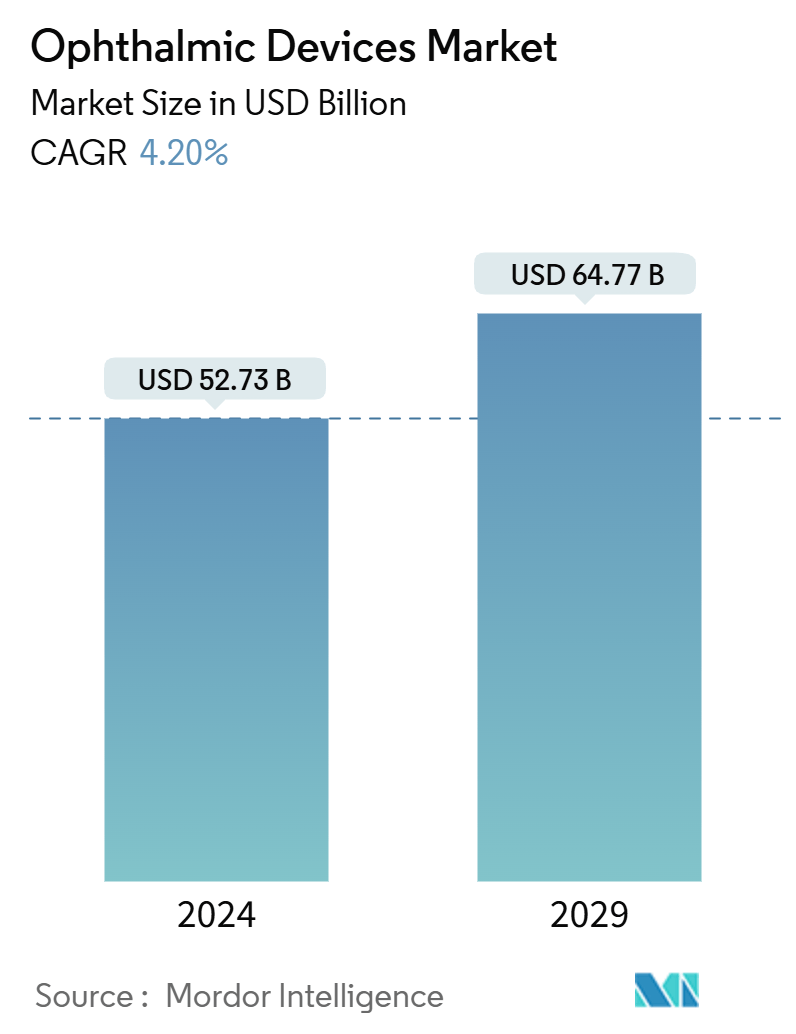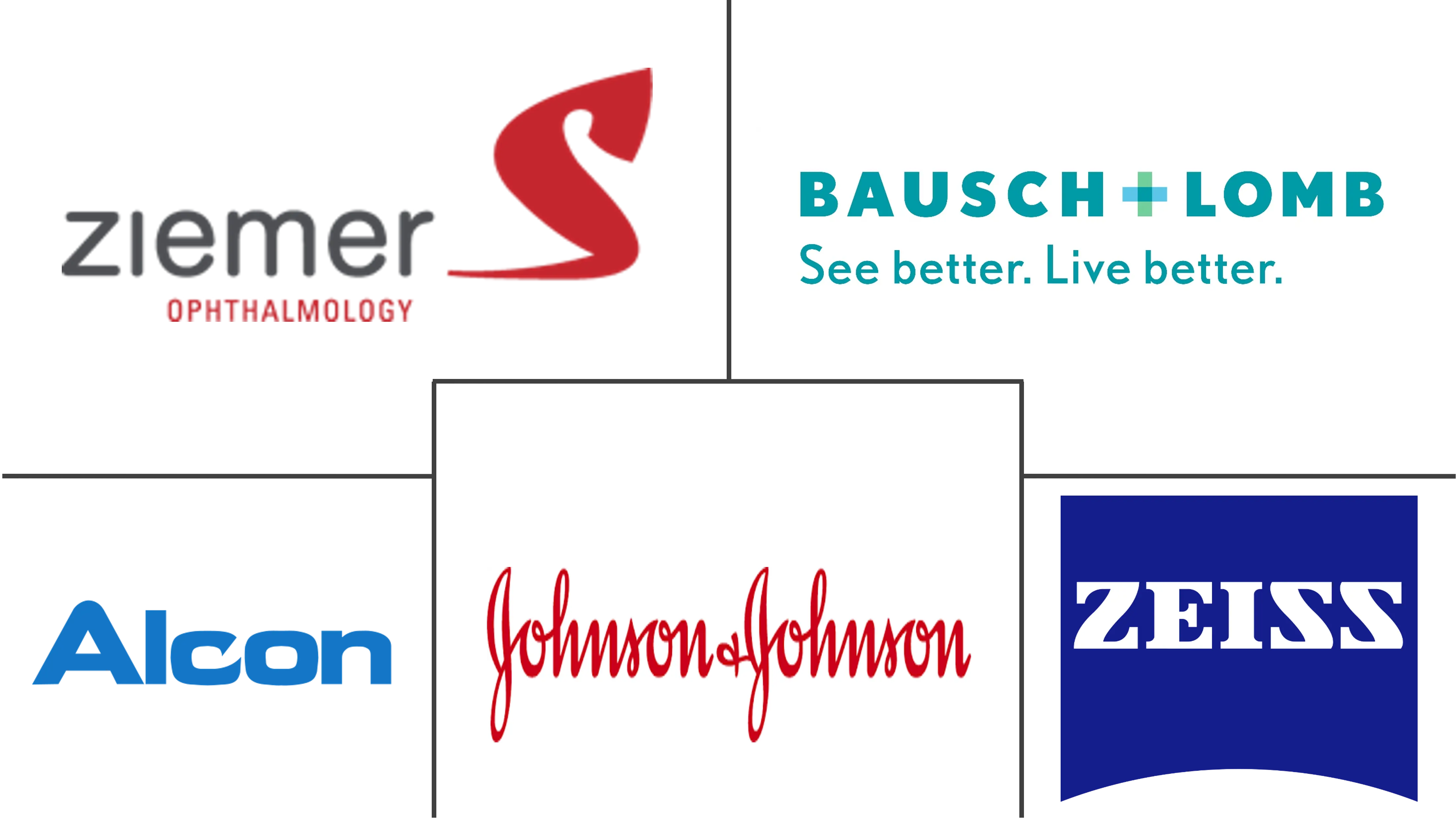Market Size of Ophthalmic Devices Industry

| Study Period | 2019 - 2029 |
| Market Size (2024) | USD 52.73 Billion |
| Market Size (2029) | USD 64.77 Billion |
| CAGR (2024 - 2029) | 4.20 % |
| Fastest Growing Market | Asia Pacific |
| Largest Market | North America |
| Market Concentration | Medium |
Major Players
*Disclaimer: Major Players sorted in no particular order |
Ophthalmic Devices Market Analysis
The Ophthalmic Devices Market size is estimated at USD 52.73 billion in 2024, and is expected to reach USD 64.77 billion by 2029, at a CAGR of 4.20% during the forecast period (2024-2029).
The COVID-19 epidemic has resulted in considerable service reductions throughout the NHS, with ophthalmology being one of the most severely impacted specialties. According to a study published in March 2021 in the British and Irish Orthopaedic Journal, outpatient clinic appointments were reduced by 87.2%, ophthalmic surgery by 90.9%, outpatient referrals to ophthalmology by 50.2%, and ward reviews by 50% during the first peak of the pandemic. There were 1,377 canceled appointments, with 6.8% of them deemed appropriate for teleophthalmology. Another study published in BMC Ophthalmology in May 2022 found that during the COVID-19 health emergency, retina clinic volume fell by 62%. The average time from check-in to technician has decreased by 79%, total visit length has decreased by 46%, and time spent in the provider phase of care has decreased by 53%. Thus, the COVID-19 pandemic severely curtailed ophthalmology services initially, but currently, as the pandemic has subsided, the market has gained some traction, and thus the market is expected to have stable growth during the forecast period of the study.
Furthermore, ophthalmic devices are medical equipment designed for diagnosis, surgical, and vision correction purposes. These devices have gained substantial importance due to the high prevalence of various ophthalmic diseases such as glaucoma, cataracts, and other vision-related issues across the globe. According to the World Health Organisation's March 2022 update, trachoma is a public health problem in 44 countries and is responsible for the blindness or visual impairment of about 1.9 million people globally. Such a high burden of disease and the need for surgical treatment are thus driving the growth of the market.
Moreover, technological advancements in the ophthalmology field have boosted the adoption rate of these devices globally. Portable medical devices are increasingly being used for home-based diagnosis and treatment of eye disorders, allowing for the diagnosis and monitoring of eye illnesses. For instance, in August 2022, Swaraashi Netralya announced the debut of ophthalmic instruments, including an ophthalmoscope, to diagnose eye problems in adults and children in India. The Mirante SLO/OCT, a scanning laser ophthalmoscope used to acquire high-quality color pictures, was introduced in India. Similarly, in February 2023, NIDEK CO., LTD. Japan introduced the Cube Ophthalmic Surgical System, which includes revolutionary ultrasound technology to provide more powerful and effective phacoemulsification. Thus, the introduction of ophthalmic devices in the market may increase accessibility to the end user, likely boosting market growth.
Thus, the aforesaid factors are likely to have a positive impact on the growth of the market. However, poor primary healthcare infrastructure in developing and underdeveloped countries and the risk associated with ophthalmic procedures may hinder the market's growth.
Ophthalmic Devices Industry Segmentation
As per the scope of the report, ophthalmology is a branch of medical science that deals with structure, function, and various diseases related to the eye. Ophthalmic devices are medical equipment designed for diagnosis, surgical, and vision correction purposes. The Ophthalmic Devices Market is Segmented by Devices (Surgical Devices (Glaucoma Drainage Devices, Glaucoma Stents and Implants, Intraocular Lenses, Lasers, and Other Surgical Devices), Diagnostic and Monitoring Devices (Autorefractors and Keratometers, Corneal Topography Systems, Ophthalmic Ultrasound Imaging Systems, Ophthalmoscopes, Optical Coherence Tomography Scanners, Other Diagnostic and Monitoring Devices), Vision Correction Devices (Spectacles, Contact Lenses) and Geography (North America, Europe, Asia-Pacific, Middle East and Africa, and South America). The market report also covers the estimated market sizes and trends for 17 different countries across major regions, globally. The report offers the value (in USD) for the above segments.
| By Devices | ||||||||
| ||||||||
| ||||||||
|
| Geography | ||||||||
| ||||||||
| ||||||||
| ||||||||
| ||||||||
|
Ophthalmic Devices Market Size Summary
The ophthalmic devices market is experiencing a steady growth trajectory, driven by the increasing prevalence of eye disorders such as glaucoma and cataracts, alongside technological advancements in the field. These devices, essential for diagnosis, surgical interventions, and vision correction, have gained prominence due to the rising incidence of vision-related issues globally. The market's expansion is further supported by the growing geriatric population and the prevalence of refractive errors, which necessitate the use of vision correction devices. Despite the challenges posed by the COVID-19 pandemic, which significantly disrupted ophthalmology services, the market is poised for recovery and growth, bolstered by innovations and the introduction of new products.
North America is anticipated to hold a significant share of the ophthalmic devices market, attributed to factors such as high disposable income, increased awareness, and a substantial geriatric population. The region's market growth is further enhanced by the launch of advanced products and devices, as well as a focus on innovation by key market players. The competitive landscape is characterized by the presence of major companies like Alcon Inc., Bausch Health Companies Inc., and Johnson & Johnson, which are actively involved in product development and strategic partnerships to enhance their market offerings. These dynamics, coupled with regulatory approvals and new product introductions, are expected to drive the market's growth in the coming years.
Ophthalmic Devices Market Size - Table of Contents
-
1. MARKET DYNAMICS
-
1.1 Market Overview
-
1.2 Market Drivers
-
1.2.1 Demographic Shift and Increasing Prevalence of Eye Diseases
-
1.2.2 Rising Geriatric Population
-
1.2.3 Technological Advancements in Ophthalmic Devices
-
-
1.3 Market Restraints
-
1.3.1 Risk Associated with Ophthalmic Procedures
-
1.3.2 Poor Primary Healthcare Infrastructure in Developing and Under-Developed Countries
-
-
1.4 Porter's Five Force Analysis
-
1.4.1 Threat of New Entrants
-
1.4.2 Bargaining Power of Buyers/Consumers
-
1.4.3 Bargaining Power of Suppliers
-
1.4.4 Threat of Substitute Products
-
1.4.5 Intensity of Competitive Rivalry
-
-
-
2. MARKET SEGMENTATION (Market Size by Value – USD million)
-
2.1 By Devices
-
2.1.1 Surgical Devices
-
2.1.1.1 Glaucoma Drainage Devices
-
2.1.1.2 Glaucoma Stents and Implants
-
2.1.1.3 Intraocular Lenses
-
2.1.1.4 Lasers
-
2.1.1.5 Other Surgical Devices
-
-
2.1.2 Diagnostic and Monitoring Devices
-
2.1.2.1 Autorefractors and Keratometers
-
2.1.2.2 Corneal Topography Systems
-
2.1.2.3 Ophthalmic Ultrasound Imaging Systems
-
2.1.2.4 Ophthalmoscopes
-
2.1.2.5 Optical Coherence Tomography Scanners
-
2.1.2.6 Other Diagnostic and Monitoring Devices
-
-
2.1.3 Vision Correction Devices
-
2.1.3.1 Spectacles
-
2.1.3.2 Contact Lenses
-
-
-
2.2 Geography
-
2.2.1 North America
-
2.2.1.1 United States
-
2.2.1.2 Canada
-
2.2.1.3 Mexico
-
-
2.2.2 Europe
-
2.2.2.1 Germany
-
2.2.2.2 United Kingdom
-
2.2.2.3 France
-
2.2.2.4 Italy
-
2.2.2.5 Spain
-
2.2.2.6 Rest of Europe
-
-
2.2.3 Asia- Pacific
-
2.2.3.1 China
-
2.2.3.2 Japan
-
2.2.3.3 India
-
2.2.3.4 Australia
-
2.2.3.5 South Korea
-
2.2.3.6 Rest of Asia-Pacific
-
-
2.2.4 Middle East and Africa
-
2.2.4.1 GCC
-
2.2.4.2 South Africa
-
2.2.4.3 Rest of Middle East and Africa
-
-
2.2.5 South America
-
2.2.5.1 Brazil
-
2.2.5.2 Argentina
-
2.2.5.3 Rest of South America
-
-
-
Ophthalmic Devices Market Size FAQs
How big is the Ophthalmic Devices Market?
The Ophthalmic Devices Market size is expected to reach USD 52.73 billion in 2024 and grow at a CAGR of 4.20% to reach USD 64.77 billion by 2029.
What is the current Ophthalmic Devices Market size?
In 2024, the Ophthalmic Devices Market size is expected to reach USD 52.73 billion.

